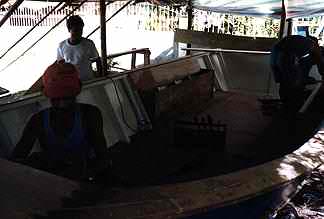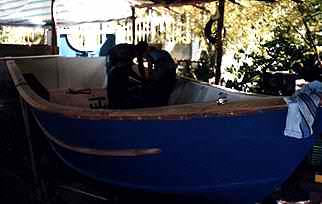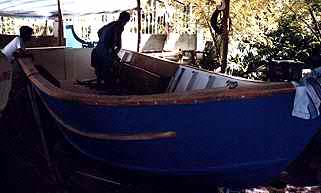
Photos twelve, thirteen, and fourteen - the exterior of the hull has been painted, allowed to dry for several days and then turned over. Be sure to save a small amount of paint leftover to do touchup once the hull has been righted. Turning the hull over is always a source of anxiety, but is actually easily accomplished with lots of hands and a few automobile tires, strategically placed. Visions of the hull splitting in half once the boat is on its side or perhaps the flipped hull coming to rest on top of a couple of your former friends always seem to come to me. After all, the finished hull of this boat is BIG! However, not to worry, the way the boat is designed and constructed makes it easily able to withstand any strains which may occur while the hull is being righted.
The inside of the boat is enormous and can be finished off in any fashion
you may choose. Because the sides of this boat are at a steep angle, I have
found that a good way to use some of the space is by constructing hinged seats
on either side. As you can tell from the picture, the bottom of the  seat is attached directly to the deck
and side frames so it does not take up any deck space. You can make them long
enough to hold fishing rods, gaff hooks, scrub brushes, tackle boxes, life
jackets, nagging mother-in-laws, or anything else you can think of. Another
nice thing about the steep sides of the boat is that is quite convenient for
the placement of rod holders. They can be bolted to the frames and your fishing
rods will angle out to the sides. You can have four rod holders (two on each
side). PVC pipe works great. Put a small throughbolt at the bottom of each
holder which locks into the butt of your fishing rod. This way the rod will not
turn while you are trolling. Also, Make the back holders slightly longer (so
the rod sits lower in the holder). This way when you are trolling four rods and
you make a turn with the boat, the line from the top of the rod in the front
holder will easily clear the rod tip of the back fishing rod and won't
catch the line on the rod tip.
seat is attached directly to the deck
and side frames so it does not take up any deck space. You can make them long
enough to hold fishing rods, gaff hooks, scrub brushes, tackle boxes, life
jackets, nagging mother-in-laws, or anything else you can think of. Another
nice thing about the steep sides of the boat is that is quite convenient for
the placement of rod holders. They can be bolted to the frames and your fishing
rods will angle out to the sides. You can have four rod holders (two on each
side). PVC pipe works great. Put a small throughbolt at the bottom of each
holder which locks into the butt of your fishing rod. This way the rod will not
turn while you are trolling. Also, Make the back holders slightly longer (so
the rod sits lower in the holder). This way when you are trolling four rods and
you make a turn with the boat, the line from the top of the rod in the front
holder will easily clear the rod tip of the back fishing rod and won't
catch the line on the rod tip.
A longer PVC rod holder can be placed mid-ship on each side of the boat (see picture) and can be used for outrigger holders. All you need is two long poles-one for each side of the boat. Bamboo poles work great. Twelve to Sixteen feet in length seem to work well. Because of the steep angles of the sides of the boat you will not need any expensive hardware to make the outriggers swing out to the fishing position-they are already at the correct angle. The poles can be removed and stowed under the seats or on the deck when not in use. Large fish boxes can be added and used for additional seats.

Overall, I have to say that I really love the design of the V-dory and find it a very functional boat, which suits my needs in every way. When I fished my V-dory in the Pacific Ocean off Kwajalein Atoll in the Marshall Islands, I found that I was able to fish rougher water than most of the other boats of the same size. The High bow and flared sides are very effective at keeping the heavy seas outside your boat where they belong. The steep sides can be viewed as being detrimental when bottom fishing, but the bench seats, rod holders and outrigger arrangements mentioned above easily make up for any negatives.
Another thing I did to my boat on Kwajalein was to cut slabs of polyurethane foam and place them between all the frames both under the deck and on the sides of the boat. This worked great as added flotation and kept the hull afloat during periods of torrential rains.
A couple of people have emailed me about how to find the correct angles at
various points when building the boat and I told them about a simple tool which
I use. It is easy to make and can find a place in any boatbuilders
toolbox.
1. Obtain one hacksaw blade (used is OK).
2. Cut the blade in half.
3. Drill a small hole through the round ends of the two pieces.
4. Place a small bolt and nut through the drilled holes and connect the two
round ends.
5. Snug the bolt, but do not overtighten. This will give you an L-shaped tool,
which can be adjusted to capture angles in tight places and then transfer them
to your wood which is to be cut. Simple but very effective.
If anyone visits the Philippines and would like to see my boat or go fishing
or diving or exploring in a beautiful setting, please visit my web site
at:
http://www.geocities.com/TheTropics/Reef/5410
Best Regards,
Bill Lovelock
blovelock@hotmail.com